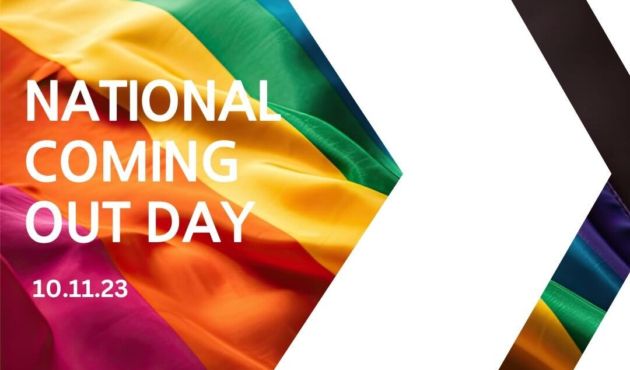National Coming Out Day

October 12, 1988, is recognized as the first National Coming Out Day in the United States. On this date in 1988, it had been a year since the National March on Washington for Lesbian and Gay Rights. There had been growing anger within the LGBTQ+ community over the mistreatment of the LGBTQ+ individuals and the lack of action in response to the AIDS epidemic. Coming out became a way to showcase freedom from the closet that had been constructed by the fears of rejection, judgment, stigma, and society’s repulsion during a turbulent era.
Flash forward 35 years and we still see echoes of that period. After seeing such large movements forward in the march towards equality and acceptance since the start of the 21st century, the LGBTQ+ community is once again facing roadblocks making coming out and living authentically queer a challenge. To the generation currently entering the workforce, being out at work may seem like a no-brainer. They have come of age where diversity has been celebrated and welcomed which is in stark contrast to ‘Don’t Ask Don’t Tell’ and other anti-LGBTQ+ policies and unspoken rules which meant that sharing your sexuality could result in retaliation both personally and professionally. This may be why many older individuals have not or will not come out until they have reached a level of status in their career when they feel comfortable, secure, and welcomed.
Looking at National Coming Out Day through the lens of employment, we must remember that members of the LGBTQ+ community do not just come out just once, but instead individuals must come out every time they start a new job or position, have a new colleague join their team, move to a new office, and/or introducing themselves to a new client or external stakeholder. The Human Rights Campaign (HRC) has created a resource for those considering coming out at work, and that decision may take more soul searching than others. Having well-documented policies around LGBTQ+ protection; supporting community organizations, such as Out in Finance; and supporting a Pride Employee/Business Resource Group (E/BRG) which hosts events and recognizes important LGBTQ+ days of significance, such as National Coming Out Day, are vital to fostering an inclusive culture at work. While having these practices and a high score on the HRC’s Corporate Equality Index are not a guarantee that someone will be comfortable coming out at work, they are steps a company can take to ensure employees feel welcome at work.
National Coming Out Day can also be a day which can cause stress to those who are still closeted. Coming out is a deeply personal decision and a day commemorating that step in someone’s journey can act as both an empowering influence and a looming reminder that they are not ready while so many others seem to be more emotionally prepared than them. The Muse, a values-based career platform, shared in their coming out guide that “[individuals] have to do what feels right for [them]. The bottom line is that your decision of whether or not to come out at work is obviously a matter of personal preference”. No one knows the maelstrom of emotions swirling in a person’s head when they are considering coming out so colleagues, friends, and allies should not demonize an individual’s choice if they are not emotionally prepared. I would be remiss if I did not reaffirm that coming out is a personal decision. I want to emphasize that outing someone is never acceptable. It can be detrimental to a person’s emotional wellbeing, destroy that person’s trust of you, or worse.
Further still, there are those employees who are comfortable sharing their sexuality but choose to not wear it on their sleeve. They may not have a picture of their partner on their desk or participate in Pride events but they will be a silent supporter of the community. Covering, meaning to downplay aspects of your identity that are based on race, gender, sexual orientation, religion, and/or disability, in an effort to “fit in” and get ahead professionally, can also be a part of the coming out process. For individuals who choose to ‘cover’, it may be easier to do their work and achieve success without needing to broadcast their sexuality. Whether or not this is seen as helpful or harmful is a matter of opinion – what matters is that the individual has made the decision they feel works best for them.
While the idea of coming out is commonly thought of as being open about one’s sexuality, for the transgender community, it carries an entirely different meaning. Michael Cherny, in writing for The Harvard Business Review, provides a three part framework (before, during, and after) for the journey of a transgender person living as their true, authentic self. It is a very different thing when you are telling your employer and coworkers about your true and authentic self – let alone the numerous changes that are happening outside of the workplace. Being supportive, listening, and not bombarding the individual with questions are the best approach. If you are close with someone who has come out as transgender, offer to spend some time with them over coffee, lunch, or after work drinks; knowing they have someone in their corner at work can make all the difference.
My hope is that someday there is no longer a need to come out. When I first entered the working world, I covered until I felt I had a support system around me. I needed to have that security because of preconceived notions of how being gay would negatively impact my career. Over time, I have realized how living my true, authentic self can and has benefited me. Being a member of the LGBTQ+ community is a differentiator, and working for a welcoming employer allows me to bring my unique perspective to my role. This may sound like a lemons into lemonade approach, but until society reaches a point where we are free from the harmful impacts of homophobic rhetoric and ideologies, I am committed to embracing my sexuality and my diversity to their fullest advantage.
Authored by
 Eric Krull
Eric Krull
Pronouns: He/Him/His
Director, Chair – Events
